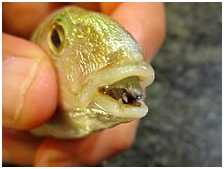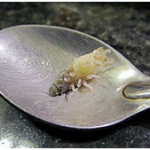
Cymothoa exigua in fish mouth. Photo from Wikipedia public domain.
A male Cymothoa exigua (a one inch crustacean) enters the mouth of a red snapper through one its gills, latches to the fish’s tongue, eats the tongue, then attaches itself to the stub of the tongue, and acts as a tongue replacement. The fish can now use the crustacean to grind food against the roof its mouth.

Cymothoa exigua. Photo from Wikipedia public domain.
Cymothoa exigua is one of a kind. No other organism is known to replace the organ of another organism in the animal kingdom. Cymothoa exigua targets the tongues of other species of fish, attaching itself to the tongue, and drinking the blood of the fish. But only in the red snapper does it eat the tongue and replace it.
Other than replacing the tongue of the fish, the crustacean does no other damage to the fish. The loss of the fish tongue means that this symbiotic relationship is parasitic. However, the fish suffers no other harm and has a replacement tongue, so one could say that this is a commensal relationship. The crustacean benefits, and the fish continues to live a ‘normal’ existence.
Recent Comments